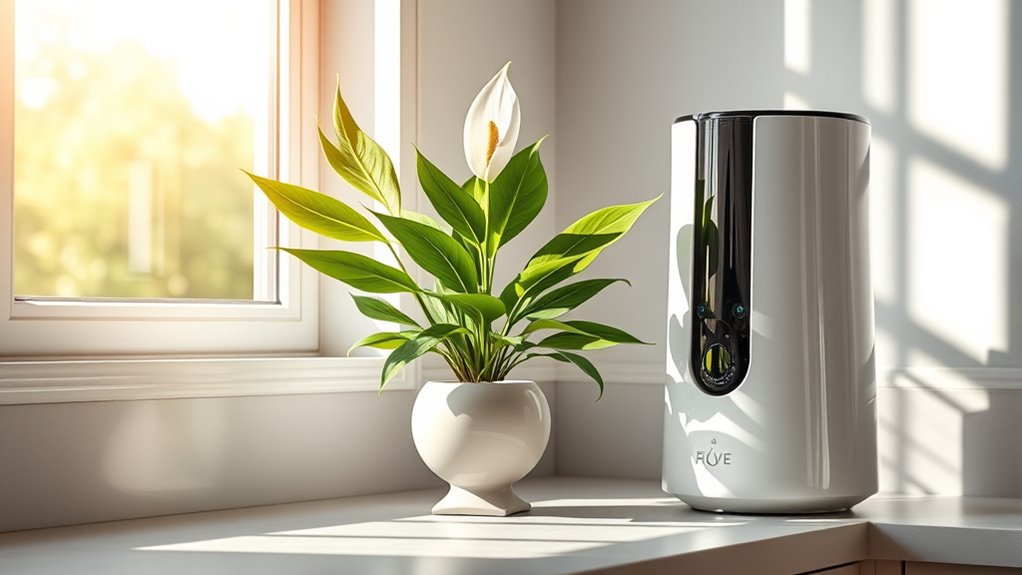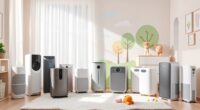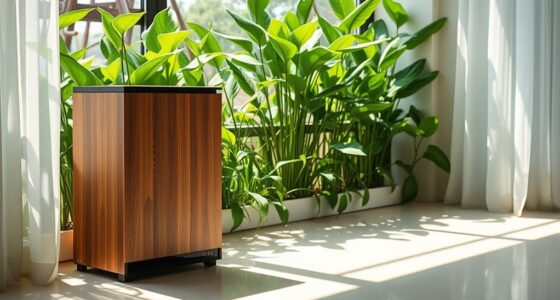Air purifiers and household plants can definitely work together to boost your indoor air quality. While air purifiers efficiently remove airborne particles, plants add aesthetic appeal and can absorb specific toxins. However, relying solely on plants isn’t effective due to their limited air cleaning capability. Combining both offers the best results for cleaner air and an inviting atmosphere. Discover how you can optimize this combination to further enhance your indoor environment.
Key Takeaways
- Air purifiers and houseplants can work together to enhance indoor air quality by targeting different types of pollutants.
- Air purifiers efficiently remove airborne particles, while plants absorb specific toxins and improve humidity levels.
- Combining both provides aesthetic appeal and contributes positively to mental well-being and stress reduction.
- Regular maintenance of air purifiers and plants is crucial for sustained air quality benefits.
- While plants offer benefits, they cannot replace the efficiency of air purifiers in significantly improving air quality.
Understanding Indoor Air Quality
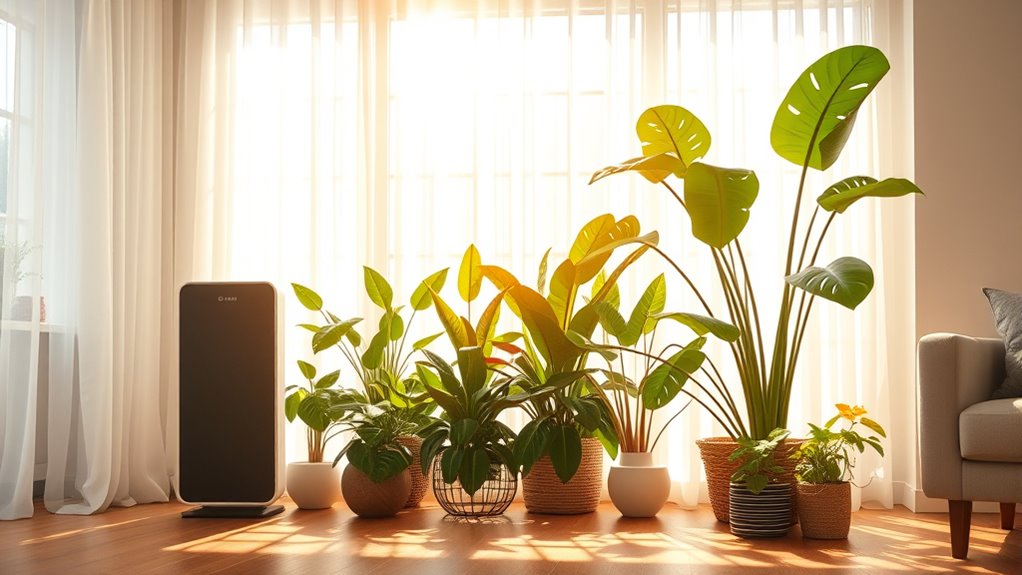
When you think about your home environment, understanding indoor air quality is essential for your health and comfort.
Regular cleaning practices, like dusting and vacuuming, play an important role in reducing airborne dust and pollutants, contributing to cleaner air. Proper ventilation is also critical in maintaining good air quality, as it helps to prevent dangerous gas buildup and allows fresh air to circulate. Additionally, HEPA filtration can effectively capture small airborne particles, further enhancing the quality of your indoor environment. Consistent maintenance of air purifiers is key to ensuring they function effectively and provide cleaner air for your home. Furthermore, using air purifiers with smart features can help monitor air quality in real-time, ensuring you stay informed about your indoor environment.
While houseplants can enhance your space, their effectiveness in improving air quality is limited; you’d need 10 to 1,000 plants per 10 square feet for noticeable results.
On the other hand, air purifiers equipped with high-efficiency filters can remove up to 99.97% of airborne particles, making them more effective for pollutant removal. Additionally, incorporating advanced technology in air purifiers can further enhance their ability to regulate indoor air quality effectively.
The Role of Air Purifiers
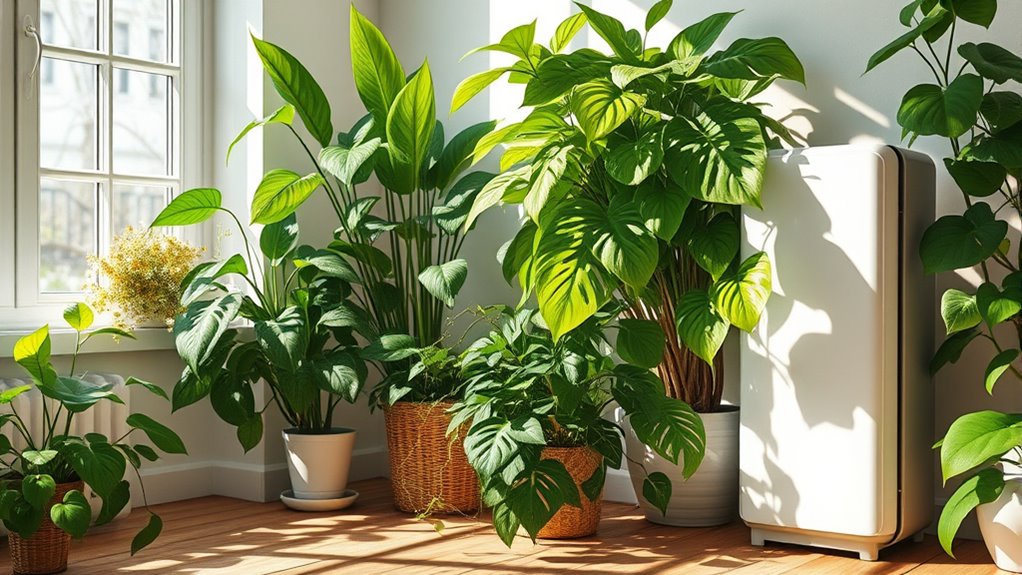
Air purifiers play an essential role in improving your indoor air quality by efficiently removing airborne particles like dust and pollen.
With minimal maintenance, they offer an easy way to keep your air clean compared to the upkeep of numerous houseplants. Plus, their ability to quickly circulate air means you’ll notice the benefits almost instantly. Additionally, the use of HEPA filters in air purifiers ensures that even the smallest particles are captured, enhancing overall air cleanliness. This effectiveness makes them a great choice for allergy sufferers, providing a significant improvement in air quality and comfort. Furthermore, many air purifiers come equipped with smart technology, allowing users to control settings remotely for optimal convenience. Regular use can lead to improved respiratory health, making air purifiers an indispensable addition to any home. Proper maintenance, such as cleaning filters regularly, is crucial for maintaining their efficiency and effectiveness.
Air Purifiers Effectiveness
While you might rely on household plants for some air purification, air purifiers equipped with HEPA filters are far more effective at removing airborne particles. These air purifiers work by capturing up to 99.97% of dust, pollen, and pet dander down to 0.3 microns, greatly reducing indoor air pollution. Additionally, activated carbon filters absorb odors and volatile organic compounds (VOCs) from household products, further improving air quality. Interestingly, some plants are known for their ability to absorb certain pollutants, similar to how air purifiers function effectively in maintaining a clean environment. In larger spaces, air purifiers circulate and cleanse the air more rapidly than plants can. Studies show that combining plants with purifiers can enhance air quality even further. User consent for data collection is vital in ensuring privacy and transparency when using devices like air purifiers. While plants purify air and add aesthetic value, combining them with air purifiers creates a holistic approach to maintaining a healthier indoor environment. Heat pumps are another technology that can enhance energy efficiency in your home, complementing the clean air benefits of purifiers and plants. Moreover, regular maintenance of your air purification systems ensures optimal performance and air quality. You’ll notice immediate benefits when you integrate both into your space.
Maintenance and Care
Maintaining ideal air quality goes beyond just having plants and purifiers in your home; it involves regular upkeep of your air purifiers. To guarantee peak performance, you should change the filters every 12 months. Regular filter cleaning and replacement are crucial for optimal performance.
While plants can absorb some pollutants, air purifiers quickly remove airborne contaminants that plants may not handle effectively. Be careful with your watering practices, as overwatering can lead to mold growth in the soil, worsening indoor air quality. Air purifiers can filter out those mold spores, helping you maintain a healthier environment. Additionally, they reduce dust accumulation on plant leaves, guaranteeing they stay healthy and don’t contribute to poor air quality. Regular cleaning schedules with robot vacuum cleaners can further enhance your indoor air quality by minimizing dust and debris accumulation. Furthermore, ensuring proper maintenance and cleaning of your air purifiers can help prevent operational issues and extend their lifespan. Incorporating non-toxic XL houseplants can also enhance your home’s aesthetic while ensuring the safety of your pets.
Moreover, the ability of air purifiers to achieve higher contrast ratios in air quality improvement can complement the natural filtration of houseplants, leading to a more balanced environment.
Together, air purifiers and plants create a balanced approach to maintaining clean air.
Comparisons With Houseplants
Although houseplants can add beauty to your home, they can’t compete with the efficiency of air purifiers when it comes to cleaning the air. Air purifiers can filter up to 99.97% of contaminants, while plants require high concentrations to make a difference. A NASA study showed plants can absorb toxins, but you’d need many—up to 1,000 per 10 square feet—for noticeable improvement. Additionally, incorporating educational toys into a child’s playtime can foster cognitive growth, enhancing overall air quality experiences in a nurturing environment.
| Aspect | Air Purifiers |
|---|---|
| Efficiency | 99.97% removal of contaminants |
| Maintenance | Change filters every 12 months |
| Contribution to Air | Targets broad range of pollutants |
| Aesthetic Appeal | Minimal |
| Psychological Benefit | Limited |
In essence, combining air purifiers with plants can enhance indoor air quality and ambiance.
The Benefits of Houseplants

Houseplants not only beautify your living space but also create a calming atmosphere that can boost your mood and productivity.
These indoor plants contribute to natural air purification by absorbing carbon dioxide and releasing oxygen, enhancing your environment. Some common houseplants, like the Peace Lily and Spider Plant, are particularly effective at absorbing volatile organic compounds (VOCs) such as formaldehyde and benzene.
While they won’t dramatically improve indoor air quality, they help regulate humidity, which is beneficial for your respiratory health.
Caring for houseplants is also a rewarding hobby that offers psychological benefits, including stress reduction and a sense of accomplishment.
Myth or Fact: Can Plants Help Improve Air Quality?
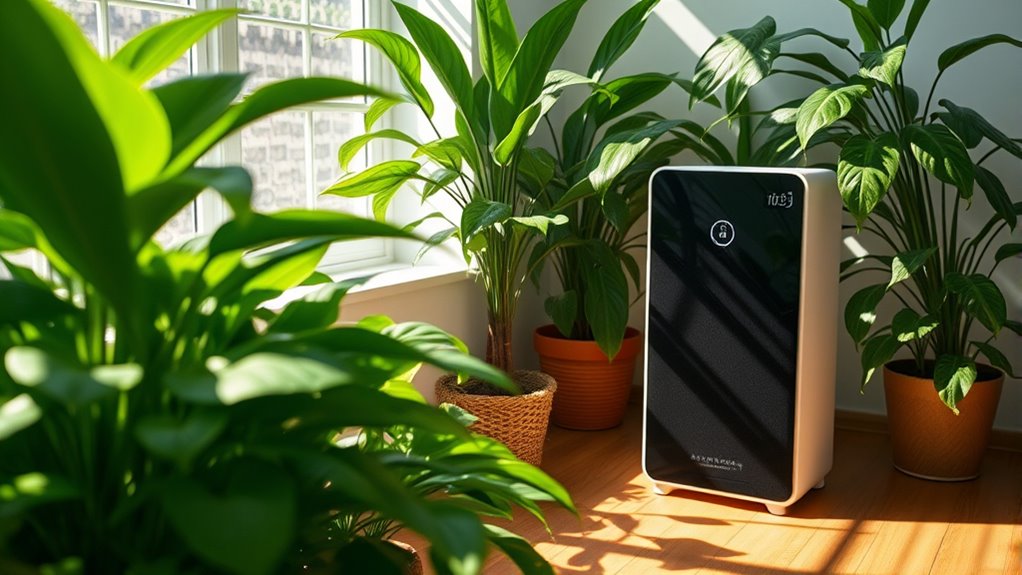
You might think that having plants in your home can considerably improve air quality, but the reality is more complicated.
While they offer aesthetic and psychological benefits, their ability to purify air is limited, especially when compared to air purifiers.
Combining plants with an effective air purifier might be the best strategy for creating a healthier indoor environment.
Limited Air Quality Improvement
While many people believe that houseplants can particularly improve indoor air quality, the reality paints a more complex picture. Houseplants do absorb certain pollutants, but their overall effectiveness is limited.
Studies suggest you’d need 10 to 1,000 plants per 10 square feet for noticeable air quality improvement. In fact, a 2019 meta-analysis showed that natural ventilation and regular cleaning are far more effective than relying solely on plants.
While they can reduce specific volatile organic compounds (VOCs) like formaldehyde, their impact diminishes in larger spaces filled with various household products. Additionally, overwatering can lead to mold, worsening indoor air quality.
For significant improvement, consider using air purifiers with HEPA filters, which can remove up to 99.97% of airborne particles.
Aesthetic and Psychological Benefits
Incorporating plants into your living space can transform the atmosphere, offering both aesthetic appeal and psychological benefits.
While they don’t greatly improve indoor air quality without a large number of plants, they still provide a calming vibe that can reduce stress and boost your mood.
With the right selection, plants can help with humidity regulation, which is beneficial for respiratory health.
However, think of them as a supplementary enhancement rather than your main solution for air quality issues.
Combining plants with air purifiers allows you to enjoy the beauty of greenery while effectively managing air quality.
This blend addresses both indoor air cleanliness and your overall psychological well-being, creating a healthier, happier environment in your home.
Optimal Combination Strategies
Although many believe that houseplants alone can greatly improve indoor air quality, the reality is more complex. Combining plants and air purifiers offers the best results. While plants provide aesthetic benefits and can absorb certain toxins, their impact is limited without a significant number of them. Air purifiers, especially those with HEPA filters, excel at removing pollutants, improving air quality rapidly. Together, these solutions create a holistic approach, enhancing humidity and mood while targeting a wider range of airborne contaminants. For ideal results, use both in your home.
| Strategy | Benefits | Best For |
|---|---|---|
| Plants Alone | Aesthetic & Psychological | Low pollutant environments |
| Air Purifiers | Efficient Pollutant Removal | High allergen or pollutant areas |
| Combined Use | Balanced Air Quality | Overall indoor air improvement |
| Regular Maintenance | Sustained Air Cleaning | Long-term health benefits |
How Air Purifiers and Plants Work Together
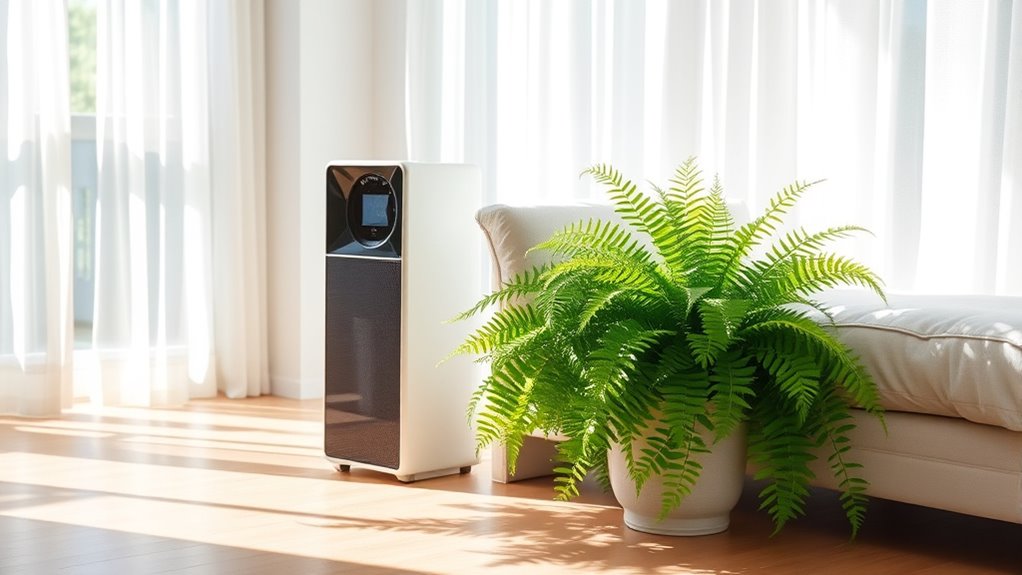
When you combine air purifiers and houseplants, you create a dynamic duo that enhances your indoor air quality. Here’s how they work together:
- Pollutant Removal: Air purifiers effectively remove airborne contaminants like dust and volatile organic compounds (VOCs), ensuring a cleaner environment.
- Humidity Regulation: Plants help maintain humidity levels, which can improve respiratory health and comfort in your home.
- Aesthetic and Mental Boost: The presence of plants not only brightens your space but also contributes positively to your mental well-being.
Together, air purifiers handle the bulk of the cleaning, while strategically chosen plants complement this by enhancing the overall atmosphere.
Air purifiers manage the heavy lifting of air cleaning, while selected plants enrich your home’s ambiance.
This combination ultimately leads to fresher, healthier indoor air quality.
Popular Air-Purifying Plants
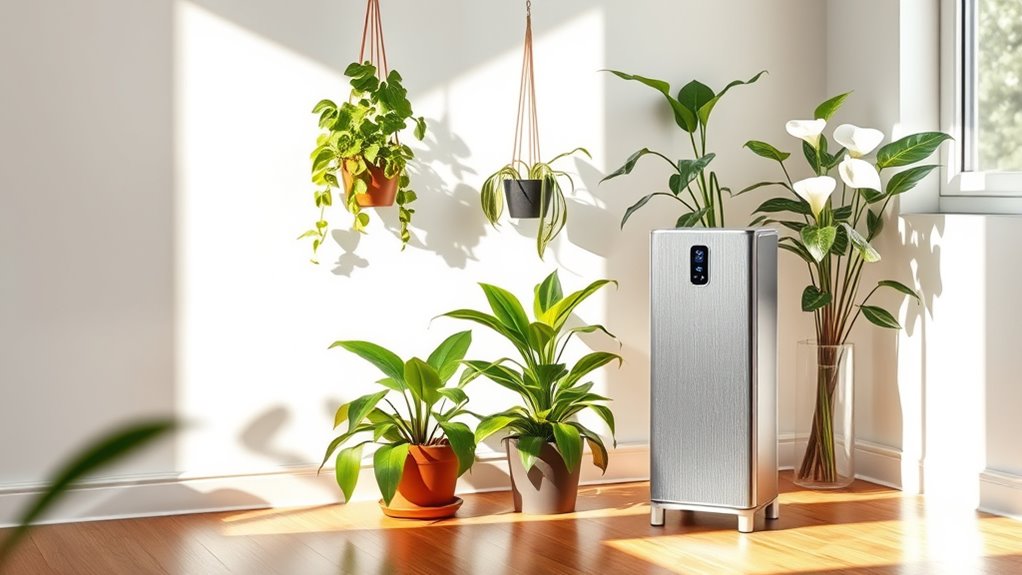
Many homeowners are turning to popular air-purifying plants to boost indoor air quality while adding a touch of greenery to their spaces.
The Snake Plant filters formaldehyde and benzene, while the Peace Lily reduces airborne mold spores, though it’s toxic to pets.
If you have animals, consider the Spider Plant, which removes carbon monoxide and is pet-friendly.
Boston Ferns raise humidity levels and filter pollutants but need extra care.
Pothos plants thrive in various conditions, efficiently removing indoor pollutants, but should be kept out of reach of pets.
NASA’s research highlights other effective plants like Warneckii, English Ivy, and Janet Craig, demonstrating how these houseplants can enhance clean indoor air even without activated carbon filters.
Limitations of Houseplants for Air Quality
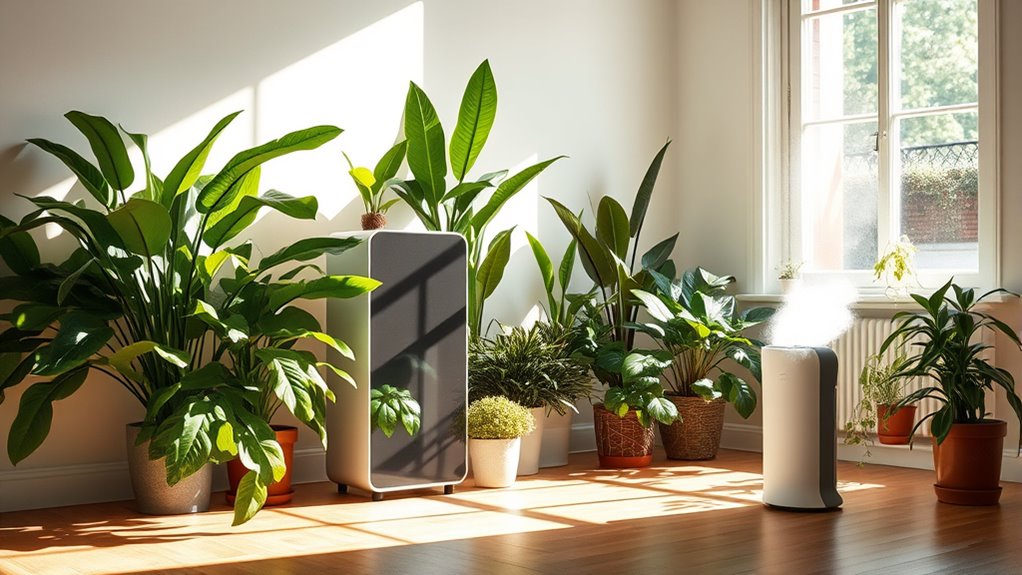
While houseplants can enhance your living space, their ability to greatly improve air quality is limited. Here are a few key points to take into account:
- Insufficient Quantity: You’d need between 10 to 1,000 plants per 10 square feet for any noticeable effect, making it impractical for most homes.
- Limited Effectiveness: Although plants can clean the air by removing volatile organic compounds (VOCs), they struggle with harmful air pollution like particulates and microorganisms.
- Regular Care Required: Maintaining plants with regular watering and pruning is essential, as neglect can lead to mold growth, which may worsen indoor air quality.
Effective Strategies for Indoor Air Improvement
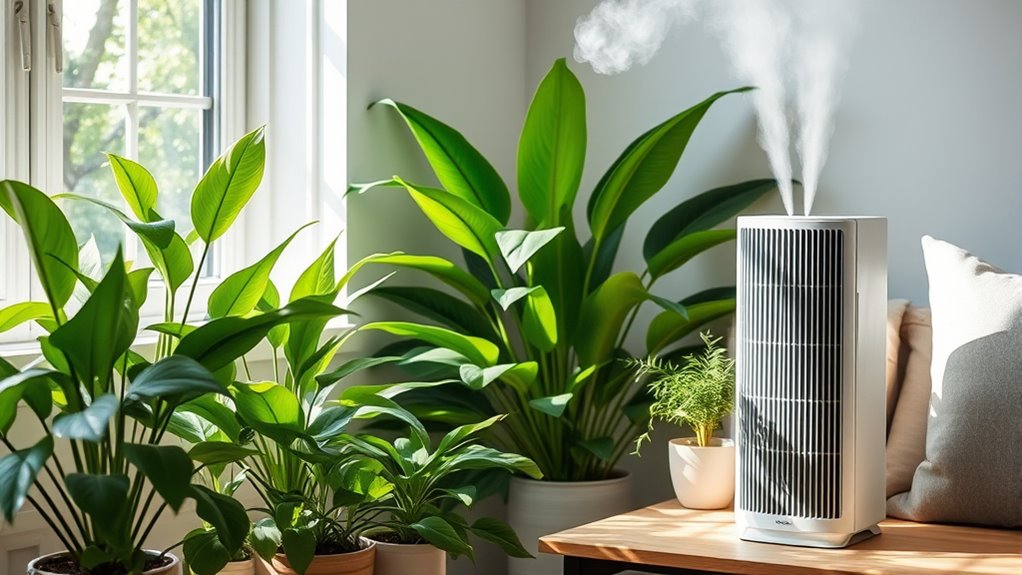
To effectively improve your indoor air quality, integrating multiple strategies is key. Combining air purifiers with plants creates a balanced approach. Air purifiers capture up to 99.97% of airborne particles and VOCs, while plants enhance humidity and provide psychological benefits.
| Strategy | Benefits |
|---|---|
| Air Purifiers | Remove fine particulates and VOCs |
| Houseplants | Improve humidity and mental well-being |
| Regular Cleaning | Reduces dust and allergens |
Utilize portable HEPA filters for wider pollutant capture. NASA recommends having 15 to 18 plants in a typical home, complementing air purifiers for ideal air quality. By combining these methods, you’ll create a healthier indoor environment.
Choosing the Right Solutions for Your Home
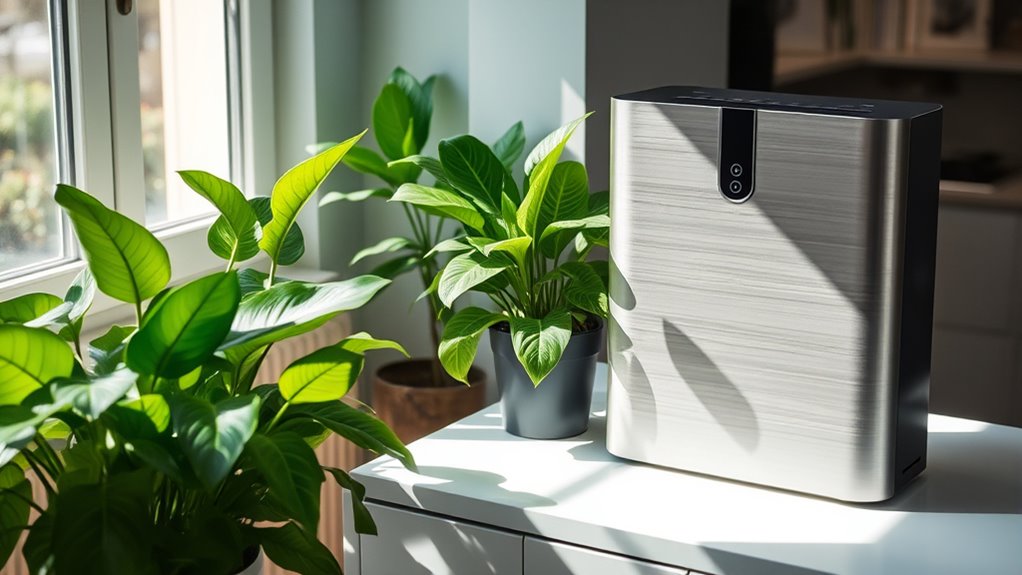
Finding the right solutions for improving indoor air quality means considering both air purifiers and houseplants. Air purifiers effectively remove airborne pollutants, while plants enhance the aesthetic of your space.
Improving indoor air quality involves using air purifiers to eliminate pollutants and incorporating houseplants for a touch of nature.
Here are some tips to optimize your choices:
- Choose a Quality Air Purifier: Look for models with HEPA filters that can eliminate up to 99.97% of particles, including volatile organic compounds (VOCs).
- Select Suitable Plants: Incorporate houseplants that thrive indoors and can help increase humidity, benefiting your overall environment.
- Maintain Both Options: Regularly change air purifier filters and care for your plants to guarantee they’re both working to improve indoor air quality effectively.
Frequently Asked Questions
Does an Air Purifier Help Plants Grow?
Yes, an air purifier can help your plants grow.
By removing airborne pollutants, it improves the air quality, which boosts photosynthesis. Your plants can absorb more carbon dioxide and release oxygen more effectively.
Plus, reducing dust on leaves lets them absorb light better, promoting growth.
If you maintain the right humidity levels alongside your purifier, it can create an ideal environment for your plants to thrive even more.
What Plant Removes 78% of Airborne Mold?
If you’re looking for a plant that removes 78% of airborne mold, the Peace Lily is your best bet.
This beautiful houseplant thrives in low to medium light and can help improve your indoor air quality. Just remember to keep it out of direct sunlight, as that can damage its leaves.
Also, be cautious if you have pets, since Peace Lilies are toxic to them if ingested. Regular care will maximize its benefits.
Where Should You Not Put an Air Purifier?
Imagine your air purifier as a vigilant knight, tasked with defending your castle from airborne invaders.
To guarantee its success, don’t confine it to corners or cramped spaces where it can’t spread its protective wings. Keep it away from walls, furniture, and heat sources that might hinder its strength.
Also, avoid placing it in humid areas or near windows, where outside threats can slip through.
Give your knight room to breathe and thrive!
What Plant Is NASA Recommend for Air Purifiers?
If you’re looking for plants that NASA recommends for air purifiers, consider the Peace Lily, Spider Plant, and Snake Plant.
These plants effectively absorb common indoor air pollutants like formaldehyde and benzene. Their larger leaf surface area enhances their ability to detoxify the air around you.
Incorporating these plants into your home not only helps improve air quality but also adds a touch of nature and beauty to your living space.
Conclusion
In the battle for cleaner air, you’ve got powerful allies: air purifiers and houseplants. But don’t be fooled—while they can work together, their effectiveness isn’t guaranteed. Imagine breathing easier, surrounded by greenery, yet missing out on the full potential of both. Are you ready to reveal the secret to truly fresh air? By understanding their roles and limitations, you’ll discover the best strategy for your home. The choice is yours—will you take the leap?
